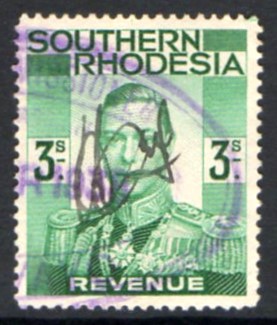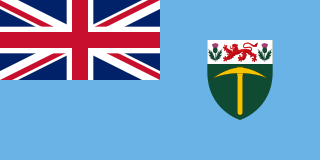
Southern Rhodesia was a landlocked self-governing British Crown colony in southern Africa, established in 1923 and consisting of British South Africa Company (BSAC) territories lying south of the Zambezi River. The region was informally known as south Zambesia until annexed by Britain at the behest of Cecil Rhodes's British South Africa Company, for whom the colony was named. The bounding territories were Bechuanaland (Botswana), Northern Rhodesia (Zambia), Moçambique (Mozambique), and the Transvaal Republic.

The prime minister of Rhodesia was the head of government of Rhodesia. Rhodesia, which had become a self-governing colony of the United Kingdom in 1923, unilaterally declared independence on 11 November 1965, and was thereafter an unrecognized state until 1979. In December 1979, the country came under temporary British control, and in April 1980 the country gained recognized independence as Zimbabwe.

Sir Roland "Roy" Welensky was a Northern Rhodesian politician and the second and last Prime Minister of the Federation of Rhodesia and Nyasaland.

The United Federal Party (UFP) was a political party in the Federation of Rhodesia and Nyasaland.

Rhodesia, known initially as Zambesia, is a historical region in southern Africa whose formal boundaries evolved between the 1890s and 1980. Demarcated and named by the British South Africa Company (BSAC), which governed it until the 1920s, it thereafter saw administration by various authorities. It was bisected by a natural border, the Zambezi. The territory to the north of the Zambezi was officially designated Northern Rhodesia by the company, and has been Zambia since 1964; that to the south, which the company dubbed Southern Rhodesia, became Zimbabwe in 1980. Northern and Southern Rhodesia were sometimes informally called "the Rhodesias".

The Zimbabwe Broadcasting Corporation (ZBC) is the state-owned broadcaster in Zimbabwe. It was established as the Rhodesian Broadcasting Corporation (RBC), taking its current name in 1980. Like the RBC before it, the ZBC has been accused of being a government mouthpiece with no editorial independence.

The Governor of Southern Rhodesia was the representative of the British monarch in the self-governing colony of Southern Rhodesia from 1923 to 1980. The Governor was appointed by The Crown and acted as the local head of state, receiving instructions from the British Government.
Sir John Baines Johnston was a British diplomat. He is best known for being Britain's High Commissioner to Rhodesia when that colony made its Unilateral Declaration of Independence in November 1965.

The Rhodesian Air Force (RhAF) was an air force based in Salisbury which represented several entities under various names between 1935 and 1980: originally serving the British self-governing colony of Southern Rhodesia, it was the air arm of the Federation of Rhodesia and Nyasaland between 1953 and 31 December 1963; of Southern Rhodesia once again from 1 January 1964; and of the unrecognised nation of Rhodesia following its Unilateral Declaration of Independence from Britain on 11 November 1965.
The Federation of Rhodesia and Nyasaland, also known as the Central African Federation (CAF), was a semi-independent state in southern Africa that existed from 1953 to the end of 1963.

The Federation of Rhodesia and Nyasaland, also known as the Central African Federation or CAF, was a colonial federation that consisted of three southern African territories: the self-governing British colony of Southern Rhodesia and the British protectorates of Northern Rhodesia and Nyasaland. It existed between 1953 and 1963.

This is a survey of the postage stamps and postal history of Zimbabwe.
Sir John Moore Caldicott was a Rhodesian government minister.

The modern political history of Zimbabwe starts with the arrival of white people to what was dubbed Southern Rhodesia in the 1890s. The country was initially run by an administrator appointed by the British South Africa Company. The prime ministerial role was first created in October 1923, when the country achieved responsible government, with Sir Charles Coghlan as its first Premier. The third Premier, George Mitchell, renamed the post Prime Minister in 1933.

The flag of Southern Rhodesia was a blue ensign, later changed to a sky-blue ensign, with the coat of arms of Southern Rhodesia on it. The flag was in use in Southern Rhodesia from 1924 to 1953 and from 1963 to 1965. It was also used by the unrecognised Rhodesia from 1965 to 1968. The flag was initially used unofficially internally before being approved for use outside of the colony by the Colonial Office in 1937. The colour was changed to sky blue in 1964 to protest the treatment of Southern Rhodesia after its inclusion in the failed Federation of Rhodesia and Nyasaland.

Rhodesia, now divided between Zambia and Zimbabwe, first issued revenue stamps in 1890, and Zimbabwe continues to do so to this day.

The Ministry of Health was a government ministry of Southern Rhodesia first established in 1948, with the establishment of the Federation of Rhodesia and Nyasaland the responsibility for health was a federal responsibility from 1954 to 1963. The ministry returned to Southern Rhodesia from 1963 with the end of the Federation and then Rhodesia from the country's self-proclaimed independence in 1965 to 1979, when the country transitioned from white minority rule to the multiracial democracy of Zimbabwe.

The Rhodesia Prison Service (RPS) was a law enforcement agency of Rhodesia. A subdivision of the Rhodesian Security Forces, it was responsible for the administration of the Rhodesian prison system. Established in 1954 as the Southern Rhodesia Prison Department and incorporated into the federal prison service of the Federation of Rhodesia and Nyasaland, it continued as the prison service of independent Rhodesia during the UDI period. Upon Zimbabwe's independence in 1980, it was dissolved and superseded by the Zimbabwe Prison Services.
State House, formerly known as Government House, is the official residence of the President of Zimbabwe and is located in Harare, Zimbabwe. It was previously used by the Administrator of Southern Rhodesia, Governor of Southern Rhodesia and the Governor-General of the Federation of Rhodesia and Nyasaland in addition to being occupied by the internationally unrecognised Rhodesian Officer Administering the Government and later President of Rhodesia. It was constructed in 1910 to a design by Detmar Blow in the Cape Dutch revival style.

Rhodesia, was a self-governing British Crown colony in southern Africa. Until 1964, the territory was known as Southern Rhodesia, and less than a year before the name change the colony formed a part of the Federation of Rhodesia and Nyasaland and hosted its capital city, Salisbury. On 1 January 1964, the three parts of the Federation became separate colonies as they had been before the founding of the Federation on 1 August 1953. The demise of the short-lived union was seen as stemming overwhelmingly from black nationalist movements in Northern Rhodesia and Nyasaland, and both colonies were fast-tracked towards independence - Nyasaland first, as Malawi, on 6 July 1964 and Northern Rhodesia second, as Zambia, on 24 October. Southern Rhodesia, by contrast, stood firmly under white government, and its white population, which was far larger than the white populations elsewhere in the erstwhile Federation, was, in general, strongly opposed to the introduction of black majority rule. The Southern Rhodesian prime minister, Winston Field, whose government had won most of the federation's military and other assets for Southern Rhodesia, began to seek independence from the United Kingdom without introducing majority rule. However, he was unsuccessful and his own party, the Rhodesian Front, forced him to resign. Days prior to his resignation, on Field's request, Southern Rhodesia had changed its flag to a sky blue ensign defaced with the Rhodesian coat of arms, becoming the first British colony to use a sky blue ensign instead of a dark blue one.














